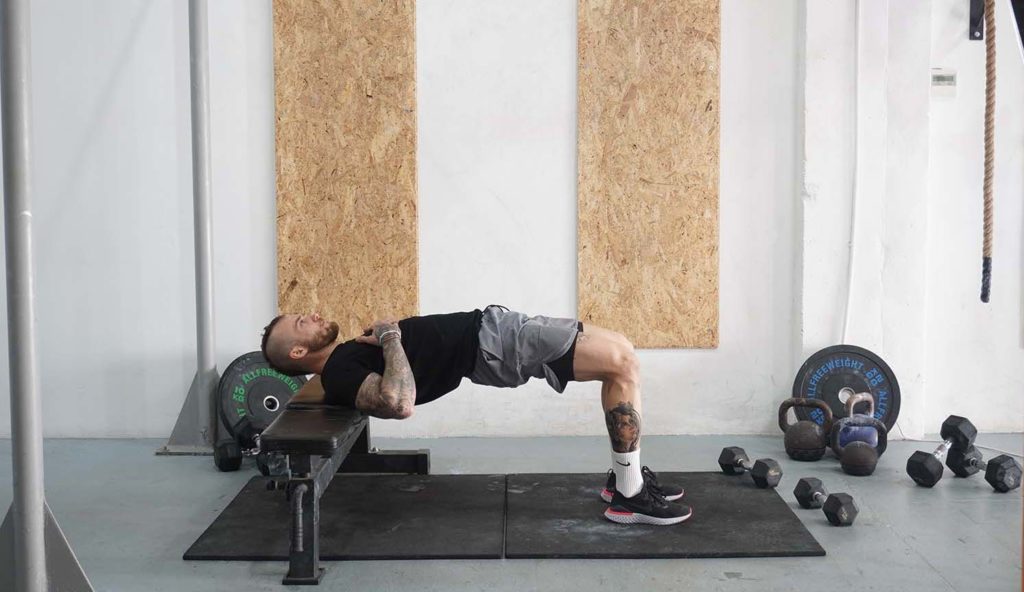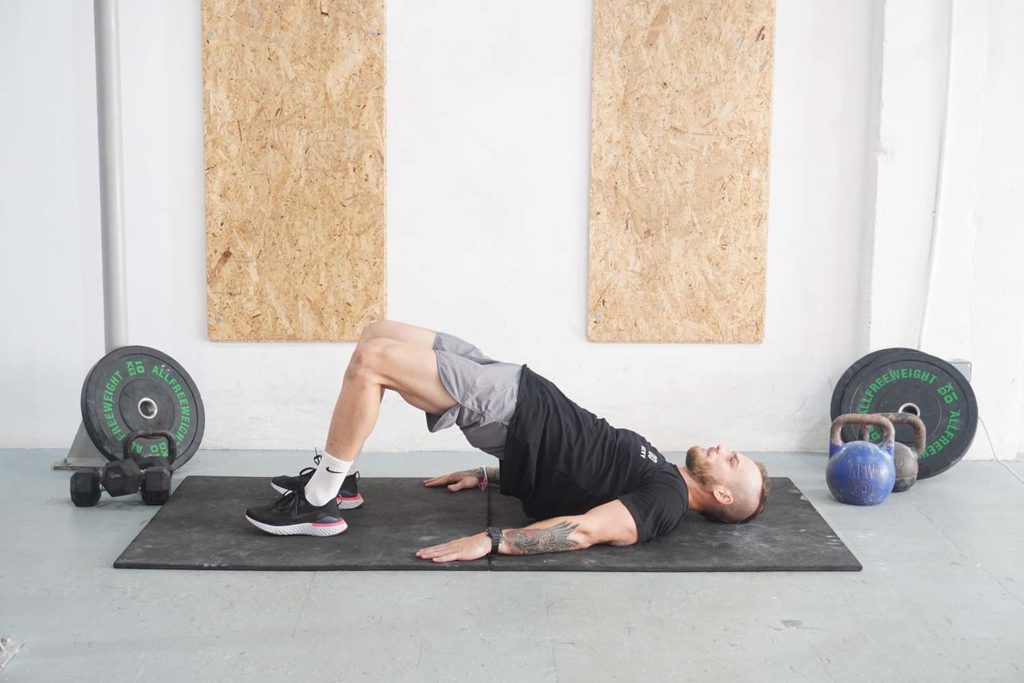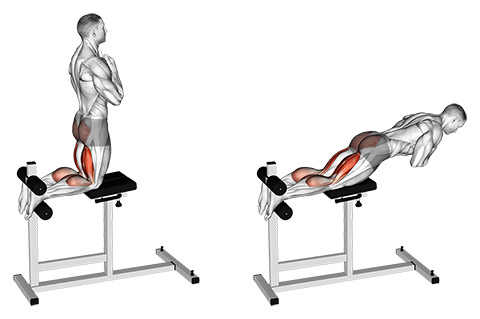What is a Single Leg Hip Thrust?
Single-leg hip thrusts are a practical accessory exercise that strengthens your glutes, hamstrings, and lower back. The back musculature plays an important stabilizing role, allowing you to maintain your balance as you perform the movement. In contrast, your glutes and hamstrings work together to produce hip extension from the bottom position.
The objective is to place your upper back on a gym bench like you would during a traditional hip thrust. You then have to lift one leg off the floor and support yourself on the other, performing the recommended number of reps. Once finished, switch legs and do the same number of reps.
Single-leg hip thrusts are beneficial for preventing side-to-side muscle imbalances from developing. Training one leg at a time forces both sides to work evenly, which stops your dominant side from taking over the movement. Similarly, training one side at a time reinforces proper technique and forces you to fix weaknesses early on.
Unilateral hip thrusts are great for glute development because of the impressive overloading potential, good range of motion, and emphasis on muscle activation. Despite being a compound movement, the hip thrust is an excellent exercise for emphasizing your glutes with more weight, leading to greater mechanical tension, strength, and muscle growth.
The primary difference between single-leg hip thrusts and glute bridges is that you perform the former on a gym bench and the latter on the floor. Plus, hip thrusts are commonly done with additional resistance, whereas the glute bridge is more of a bodyweight exercise.
We recommend including single-leg hip thrusts early in your training or possibly near the middle. Perform reps in the moderate range, making sure to train through a full range of motion and pause at the top.
Level of Exercise: Intermediate
How to do a Single Leg Hip Thrust

- Sit on a flat gym bench.
- Walk your feet out, bring your glutes toward the floor, and place your upper back against the bench.
- Bring your feet forward enough to bend your knees at a 90-degree angle and lift your buttocks to align your knees, hips, and shoulders.
- Have your feet planted firmly on the floor.
- Squeeze your glutes, engage your abs, and place the back of your upper arms against the bench for support.
- Raise one leg while keeping the knee bent at a 90-degree angle.
- Take a breath and lower your buttocks to the floor as you support yourself on one foot.
- Descend until your glutes are a few inches away from the floor. Pause for a moment, and drive through the heel to extend your hips and bring yourself to the top.
- Once finished, plant the opposite foot on the floor, raise the other one in the air, and perform the same number of slow and controlled repetitions.
We recommend getting used to the movement without adding external weights. Adding resistance to the movement would look like this:
- Set up as you usually would.
- Place a dumbbell or kettlebell over the crease of your hips.
- Lift your buttocks to align your hips, knees, and shoulders.
- Raise one foot off the floor. You might have to keep it straight because the weight over your hips will prevent you from tucking your knee.
- Perform as many slow and controlled repetitions as you can.
- Switch and train the opposite side.
What muscles does a single leg hip thrust activate?
The primary muscle group that works during a single-leg hip thrust is the gluteus maximus, which comprises a large percentage of the buttocks area (1, 2). Our glutes are responsible for numerous motions, but their primary job is hip extension (driving our hips forward), which occurs off the bottom during a hip thrust. The gluteus minimus and medius assist the glute maximus with hip extension and stability.
Our hamstrings are the second major muscle group involved in the hip thrust. The muscle group covers the rear of our thighs, spanning from the hips to the knees (3). One of the muscle’s functions is knee flexion (such as during a lying hamstring curl), but our hamstrings also assist the glutes in hip extension.
The entire back musculature also works during a single-leg hip thrust. All of the muscles in the area flex isometrically to help us maintain a solid spinal position and contribute to a stable torso. Similarly, the muscles in the midsection engage to keep us steady as we do the movement. Among them, we have the rectus and transverse abdominis, and obliques.
Our quadriceps play a minor role during any form of hip thrusts. These muscles make up the entire front area of our thighs and produce knee extension (4). As such, our quadriceps activate as we drive our hips off the bottom position.
Tips on Form and doing Single Leg Hip Thrust Safely
An important tip for safe and effective single-leg hip thrusts is to keep your hips in a steady position and avoid tilting to one side. Tilting often occurs in trainees new to the movement, but you can prevent that from happening by remaining conscious of the possibility and keeping your abs engaged.
Another tip for the movement is to start without any extra weight. Doing so is beneficial for learning proper technique and how to engage the correct muscles. You can always place a dumbbell, kettlebell, or weight plate over your hips later.
Our third tip for the movement is keeping your supporting heel on the floor and initiating the movement by driving it into the floor. Doing so makes it easy to contract your glutes and hamstrings, making each repetition more effective.
The next tip to keep in mind for effective hip thrusts is to pause at the top of each repetition. Doing so might not seem that important, but it helps with muscle activation and contributes to better mind-muscle connection, which is valuable for your long-term progress.
Another idea worth mentioning for the single-leg hip thrust is to perform each repetition through a full range of motion, even if it means training with less weight. Lower your buttocks until you’re a couple of inches off the floor, and drive your hips up until they align with your knees and torso.
Variations and Modifications of the Single Leg Hip Thrust
1. Classic Hip Thrust

The most popular modification to the single-leg hip thrust is the classic hip thrust exercise. Instead of supporting yourself on one foot, you keep both on the floor as you extend your hips repeatedly. The classic version is beneficial because the stability requirements are smaller, and you can overload your muscles with more weight.
2. Banded Single-Leg Hip Thrust
Banded single-leg hip thrusts are a variation you perform by placing a looped band over your thighs. Doing so is beneficial for improving glute activation as you keep your thighs apart to stretch the resistance band.
3. Two Up, One Down Hip Thrusts
The two up, one down hip thrust is an interesting variation for those struggling to perform the single-leg hip thrust. Instead of supporting yourself on one foot from start to finish, you extend your hips with both heels on the floor and raise one leg up on the descending portion of each rep.
Mistakes to Avoid
Arching Your Lower Back
A relatively common mistake with any hip thrust variation is arching your lower back. Doing so prevents you from keeping your abs engaged and might lead to unnecessary stress on your back. Avoid the error by engaging your abs at the start of each set, which will tuck your pelvis and place your spine in a healthy, neutral position.
Raising Your Hips too High
A mistake similar to the first one is raising your hips too high. Doing so leads to arching that stresses your spine. Avoid the error by raising your hips until they align with your knees and torso.
Placing Your Feet too Close to Your Body
Placing your feet too close to your body forces you to bend your knees more and emphasize your quadriceps. The ideal foot placement for the hip thrust is to have your shins vertical as you extend your hips.
Similar Exercises to the Single Leg Hip Thrust
Glute Bridge

As briefly mentioned earlier, glute bridges and hip thrusts share many similarities, especially as it relates to the range of motion. The glute bridge is beneficial because you can emphasize and strengthen your glutes while performing the movement on the floor (5).
Glute Ham Raise

Glute ham raises are a practical accessory exercise that strengthens your posterior chain: the glutes, hamstrings, and back (6). The objective is to stand on top of a glute ham machine, anchor your feet under special pads, and use your posterior muscles to raise and lower your torso repeatedly.

